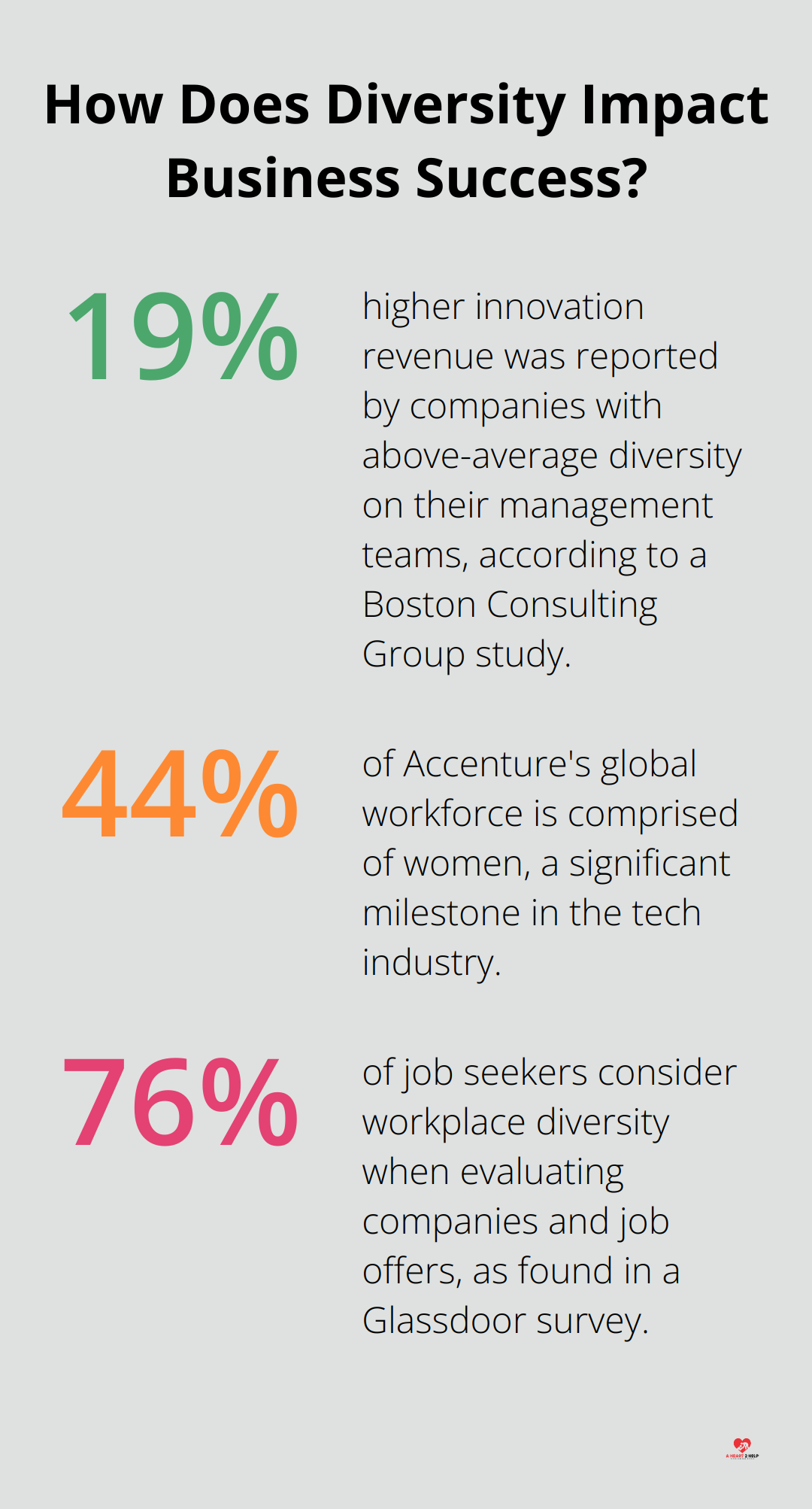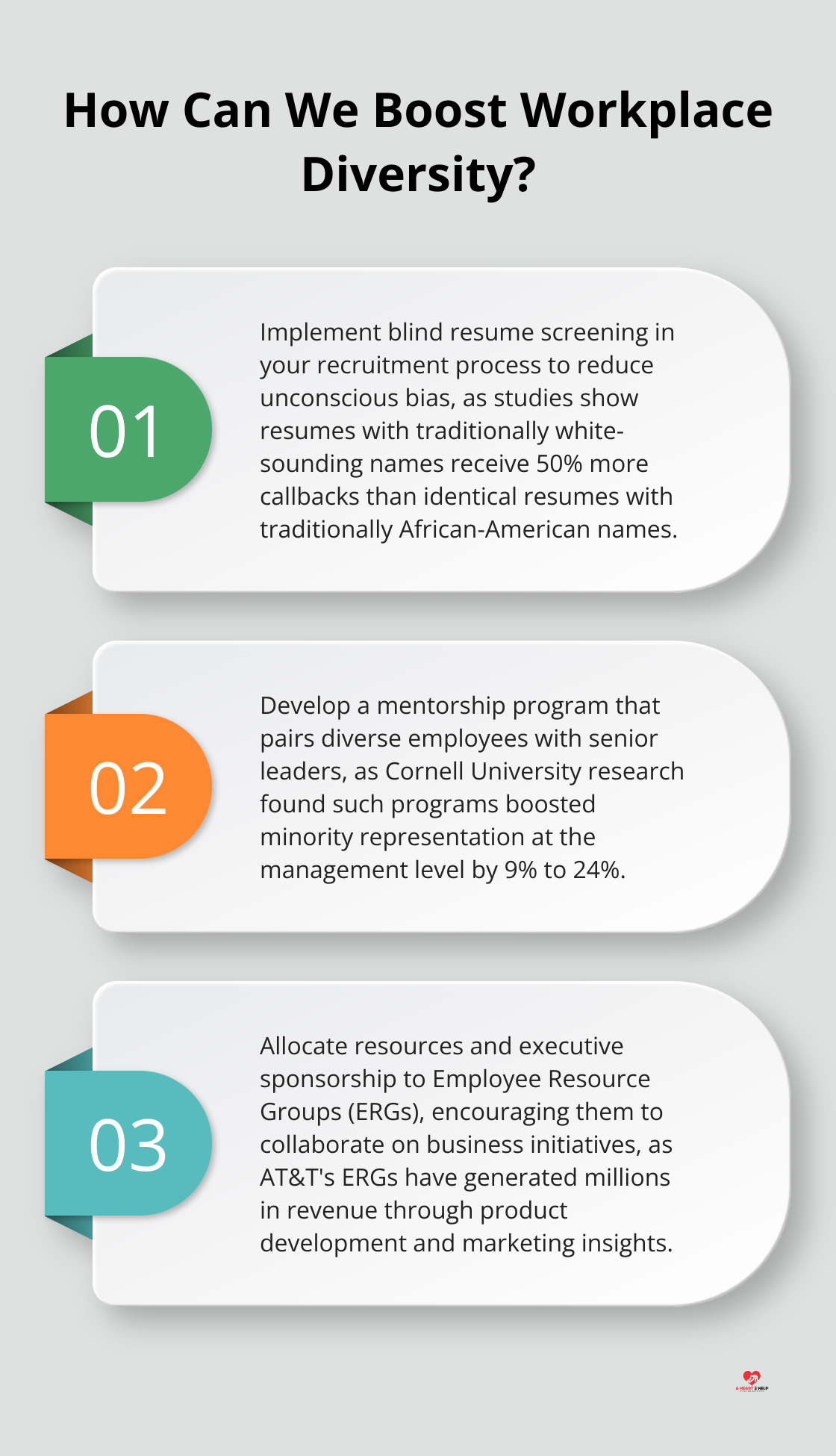At A Heart 2 Help, we’ve seen firsthand how valuing diversity in the workplace transforms organizations. Diverse teams drive innovation, boost employee satisfaction, and expand market reach.
In this post, we’ll explore real-world examples of companies successfully embracing diversity. We’ll also share practical strategies for creating a more inclusive work environment.
Why Diversity Drives Business Success
Innovation Powerhouse
Diversity is a potent tool for the growth of your business, as there is a synergy of experts with different views and ideas. Companies with diverse teams outperform their competitors in multiple areas. A Boston Consulting Group study revealed that companies with above-average diversity on their management teams reported 19% higher innovation revenue. This translates to improved products, services, and solutions that cater to a wider customer base.

Apple exemplifies this benefit. When they realized their health app didn’t track menstrual cycles, input from their diverse team led to a quick addition of this feature. This improvement not only enhanced the app but also expanded its user base.
Employee Satisfaction Skyrockets
Diversity significantly impacts employee satisfaction and retention rates. Millennials are taking on more leadership roles at work and are uniquely positioned to make the workplace more diverse and inclusive. This engagement leads to increased productivity and lower turnover rates.
Accenture demonstrates remarkable results from their diversity initiatives. Their commitment to achieve a gender-balanced workforce by 2025 has already increased women’s representation to 44% of their global workforce (a significant milestone in the tech industry).
Market Expansion and Brand Enhancement
A diverse workforce helps companies understand and serve diverse markets more effectively. According to a Harvard Business Review study, teams with members who represent target customers are up to 158% more likely to understand those customers’ needs.
L’Oréal provides an excellent example of this principle in action. By employing a multicultural workforce, they’ve successfully expanded into new markets and developed products for diverse consumer groups. This strategy contributes to their position as a global beauty leader.
Embracing diversity also enhances brand reputation. A Glassdoor survey found that 76% of job seekers consider workplace diversity when evaluating companies and job offers. This improved reputation not only attracts top talent but also resonates with consumers who prefer to support inclusive brands.
As we move forward, let’s explore how leading companies implement these principles to create truly diverse and inclusive workplaces. Their success stories provide valuable insights and inspiration for organizations aiming to harness the power of diversity.
Trailblazers in Workplace Diversity
At A Heart 2 Help, we draw inspiration from companies that champion diversity and inclusion in their workplaces. Let’s examine how some of the world’s most innovative organizations make significant strides in this area, offering valuable lessons for businesses of all sizes.
Accenture: A Benchmark for Gender Equality
Accenture sets an impressive standard for gender balance. Their ambitious goal to achieve a 50/50 gender-balanced workforce by 2025 shows promising progress. As of 2023, women constitute 44% of their global workforce and 27% of their managing directors. This success stems from targeted initiatives:
- Unconscious bias training for all employees that does more than increase awareness of bias and its impact. It teaches attendees to manage their biases, change their behavior, and take action.
- Flexible work arrangements to support work-life balance
- Mentorship programs specifically for women in leadership roles

These efforts yield tangible results. Accenture reports higher employee satisfaction rates and receives recognition as a top employer for women from various organizations.
Microsoft: Revolutionizing Inclusive Hiring
Microsoft transforms its hiring practices to create a more diverse workforce. Their approach includes:
- Expanded recruitment efforts to historically black colleges and universities (HBCUs)
- A Neurodiversity Hiring Program to attract talented neurodivergent candidates and provide the training and support needed for career growth and success
- AI tools to write more inclusive job descriptions
The outcomes speak volumes. Microsoft reports a 56% increase in women in technical roles since 2015 and has doubled the number of African American and Hispanic employees in leadership positions.
Mastercard: Embracing Multicultural Perspectives
Mastercard’s focus on building a multicultural workforce produces impressive results. Their strategies encompass:
- ‘Business Resource Groups’ to support various employee demographics
- A ‘Relaunch Your Career’ program for professionals returning to work after a career break
- Cultural competency training for all employees
These initiatives lead to Mastercard’s recognition as one of the most diverse companies globally. They report that 40% of their workforce is female, with women holding 32% of senior management positions.
The Power of Diverse Workplaces
These success stories demonstrate that diversity transcends mere quotas. It creates an environment where all employees thrive, innovate, and contribute their unique perspectives. Companies that prioritize diversity (like Accenture, Microsoft, and Mastercard) reap benefits in innovation, employee satisfaction, and market reach.
As we move forward, let’s explore how organizations can implement effective diversity strategies, drawing inspiration from these trailblazers. The next section will provide practical steps for creating inclusive workplaces, from recruitment processes to leadership development programs.
How to Build a Diverse and Inclusive Workplace
Revamp Your Recruitment Process
Organizations must overhaul their recruitment practices to foster diversity. Remove bias from job descriptions by using gender-neutral language and focusing on skills rather than years of experience. Tools can help identify potentially exclusionary language in job postings.

Implement blind resume screening to reduce unconscious bias. A study by the National Bureau of Economic Research found that resumes with traditionally white-sounding names received 50% more callbacks than identical resumes with traditionally African-American names.
Diversify your candidate sources. Partner with organizations that focus on underrepresented groups in your industry. The National Society of Black Engineers or Women in Technology International can provide access to diverse talent pools.
Develop Robust Mentorship Programs
Mentorship plays a vital role in retention and career advancement of diverse employees. A study by Cornell University found that mentoring programs boosted minority representation at the management level by 9% to 24%.
Design mentorship programs that pair diverse employees with senior leaders. This provides guidance and support while exposing leadership to different perspectives. Salesforce’s Equality Mentorship Program connects underrepresented employees with executives for career guidance.
Empower Employee Resource Groups
Employee Resource Groups (ERGs) foster inclusion powerfully. These voluntary, employee-led groups provide support, enhance career development, and contribute to personal growth in the workplace. By aligning their work with corporate and employee expectations, ERGs can help people feel more included in the workplace.
Allocate resources and executive sponsorship to ERGs. Google’s ERGs shape company policies and products significantly. Their Trans ERG was instrumental in developing transgender-inclusive healthcare benefits.
Encourage ERGs to collaborate on business initiatives. This increases their impact and demonstrates their value to the organization. AT&T’s ERGs have generated millions in revenue through product development and marketing insights.
Invest in Ongoing Education
Cultural awareness and anti-bias training should occur regularly, not as one-off events. Starbucks made headlines with its company-wide racial bias training, but consistency and practical application are key.
Implement microlearning modules on diversity and inclusion topics. These bite-sized, regular lessons can be more effective than annual day-long sessions. PwC uses this approach, offering short, frequent training sessions on various D&I topics.
Measure the impact of your training programs. Use pre and post-training surveys to assess changes in attitudes and behaviors. Unconscious bias training can be effective when done properly and can be part of a comprehensive DEI program.
Creating a truly diverse and inclusive workplace requires commitment, resources, and a willingness to continuously learn and adapt. These strategies (when implemented thoughtfully) can create environments where all employees feel valued, respected, and empowered to contribute their best work.
Final Thoughts
Valuing diversity in the workplace transforms organizations. Companies like Accenture, Microsoft, and Mastercard demonstrate the power of inclusive practices through increased innovation, employee satisfaction, and market reach. These examples of valuing diversity in the workplace prove that setting ambitious goals, implementing inclusive hiring, and creating supportive environments yield tangible results.

Organizations must prioritize diversity and inclusion to remain competitive. This requires embedding diversity into every aspect of organizational culture and operations. Companies should examine their current practices and take concrete steps towards creating more diverse and inclusive workplaces.
At A Heart 2 Help, we connect people from all walks of life through our care-app. We encourage organizations to create workplaces where every individual feels valued and empowered to contribute their unique perspectives. The time for action is now.
